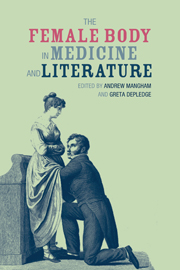Book contents
- Frontmatter
- Contents
- Acknowledgments
- Notes on Contributors
- 1 Introduction
- 2 ‘Difficulties, at present in no Degree clear'd up’: The Controversial Mother, 1600–1800
- 3 Monstrous Issues: The Uterus as Riddle in Early Modern Medical Texts
- 4 Surveilling the Secrets of the Female Body: The Contest for Reproductive Authority in the Popular Press of the Seventeenth Century
- 5 ‘Made in Imitation of Real Women and Children’: Obstetrical Machines in Eighteenth-Century Britain
- 6 Transcending the Sexed Body: Reason, Sympathy, and ‘Thinking Machines’ in the Debates over Male Midwifery
- 7 Emma Martin and the Manhandled Womb in Early Victorian England
- 8 Narrating the Victorian Vagina: Charlotte Brontë and the Masturbating Woman
- 9 ‘Those Parts Peculiar to Her Organization’: Some Observations on the History of Pelvimetry, a Nearly Forgotten Obstetric Subspeciality
- 10 ‘She read on more eagerly, almost breathlessly’: Mary Elizabeth Braddon's Challenge to Medical Depictions of Female Masturbation in The Doctor's Wife
- 11 Mrs Robinson's ‘Day-book of Iniquity’: Reading Bodies of/and Evidence in the Context of the 1858 Medical Reform Act
- 12 Rebecca's Womb: Irony and Gynaecology in Rebecca
- 13 Representations of Illegal Abortionists in England, 1900–1967
- 14 Afterword: Reading History as/and Vision
- Index
8 - Narrating the Victorian Vagina: Charlotte Brontë and the Masturbating Woman
- Frontmatter
- Contents
- Acknowledgments
- Notes on Contributors
- 1 Introduction
- 2 ‘Difficulties, at present in no Degree clear'd up’: The Controversial Mother, 1600–1800
- 3 Monstrous Issues: The Uterus as Riddle in Early Modern Medical Texts
- 4 Surveilling the Secrets of the Female Body: The Contest for Reproductive Authority in the Popular Press of the Seventeenth Century
- 5 ‘Made in Imitation of Real Women and Children’: Obstetrical Machines in Eighteenth-Century Britain
- 6 Transcending the Sexed Body: Reason, Sympathy, and ‘Thinking Machines’ in the Debates over Male Midwifery
- 7 Emma Martin and the Manhandled Womb in Early Victorian England
- 8 Narrating the Victorian Vagina: Charlotte Brontë and the Masturbating Woman
- 9 ‘Those Parts Peculiar to Her Organization’: Some Observations on the History of Pelvimetry, a Nearly Forgotten Obstetric Subspeciality
- 10 ‘She read on more eagerly, almost breathlessly’: Mary Elizabeth Braddon's Challenge to Medical Depictions of Female Masturbation in The Doctor's Wife
- 11 Mrs Robinson's ‘Day-book of Iniquity’: Reading Bodies of/and Evidence in the Context of the 1858 Medical Reform Act
- 12 Rebecca's Womb: Irony and Gynaecology in Rebecca
- 13 Representations of Illegal Abortionists in England, 1900–1967
- 14 Afterword: Reading History as/and Vision
- Index
Summary
In 1989 Eve Kosofsky Sedgwick claimed that the discipline of gynaecology emerged in the nineteenth century as a response to cultural and medical anxieties over female masturbation. Sedgwick, in her controversial article ‘Jane Austen and the Masturbating Girl’, argued for a rereading of Sense and Sensibility (1811) that allowed for the possibility of a homoerotic, or even autoerotic, identity for the novel's Dashwood sisters. While Sedgwick's approach might be described as anachronistic or even exclusionary (it implies that readers who cannot see in Austen's text what Sedgwick sees have been blinded by their own heterosexist assumptions), it does present a useful model for the juxtaposition of historical and literary texts. That is, in forging audacious links between texts in an attempt to reveal what has previously been unsaid, unheard, or unexamined, Sedgwick illustrates the impossibility of locating an objective ‘meaning’ in canonical literary works. In this essay I echo Sedgwick as I explore the rich, albeit tangential, allusiveness produced by the juxtaposition of literary and non-literary texts. In exploring Victorian gynaecological treatises and a novel, Charlotte Brontë's Villette (1853), I identify a provocative cultural narrative of staged propriety and silent restraint.
This essay, then, tells the story of how certain Victorian lives intersect and coalesce. What comes into view from the merging of the canonical and the non-canonical, the fictional and the real, is an account of how the individual sexual subject struggles to make sense of its identity in relation to the secret and unspoken complexities of the female body.
- Type
- Chapter
- Information
- The Female Body in Medicine and Literature , pp. 119 - 134Publisher: Liverpool University PressPrint publication year: 2011

